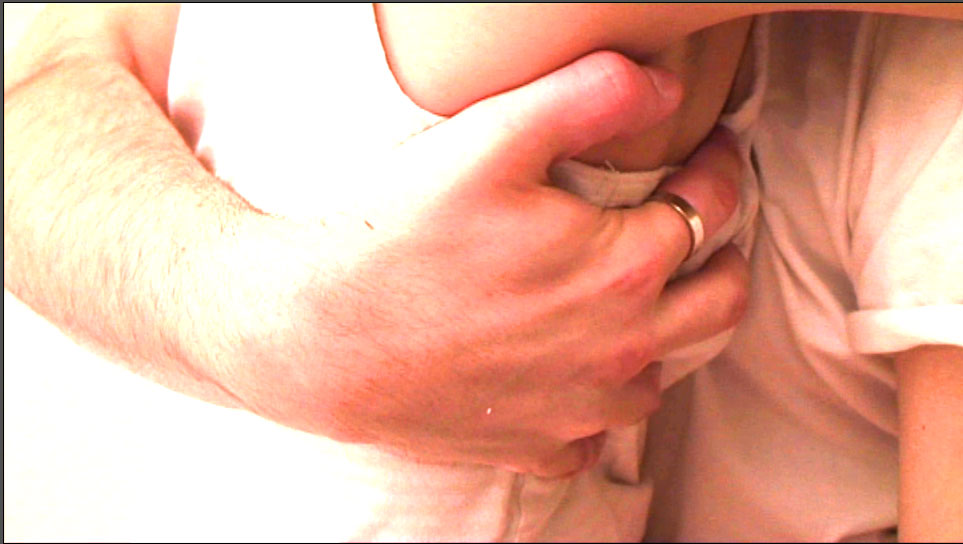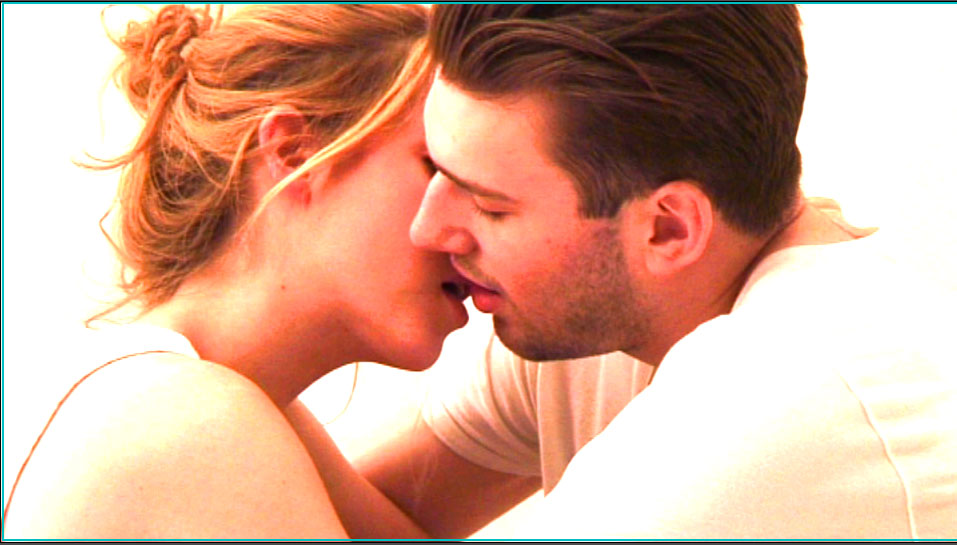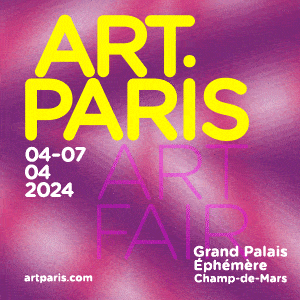Whitehot Magazine
April 2024
"The Best Art In The World"
"The Best Art In The World"
April 2024
December 2009, In Conversation with Cecile Evans

Cecile Evans, Artificial Intimicy, 2009; Video, 1:23 min; Courtesy of the artist
Ana Finel Honigman in Conversation with Cecile Evans
Justice Potter Stewart's conundrum about pornography is equally true for intimacy: Intimacy is impossible to define objectively but it is glaringly obvious to those who experience it. Yet intimacy rarely feels the same even to those in the same relationship. This confusing absence of shared understanding is what artist Cecile Evans parses in her video and installation art. Evans approaches intimacy as subject with philosophical concern, anthropological interest and poetic investment. In her work, the twenty-six year old Belgian-American artist asks people to confront how they stimulate, simulate, desire and achieve intimacy.
For the group show "Le Souci De Soi" at the Don't Projects gallery in Paris, Evans presents a video entitled "Artificial Intimacy" alongside work by Spencer Sweeney and Alexander Huxeby. "Artificial Intimacy" is about a young man who Evans met in Paris when he was 21 and the 19-year-old girl she introduced to him. After their first meeting, the couple had a dreamy night together but abruptly drifted apart. For her video, Evans reconnected them and insisted that they confront the intimate physical knowledge they had shared and the potential for long-term closeness they rejected in the aftermath of their micro-romance.
Evans was raised in Florida and studied acting at NYU before turning her attention to art. She now divides her time between Paris and Berlin. As my best friend in Berlin, Evans and I share lots of intimacies, as well as Charlie, the gorgeous girl cat we co-adopted from video art Jordan Wolfson. One of our intimate connections comes from alienating everyone who is not interested in endless cute stories about our cat. Here, however, we try to stick to the more pressing issue of defining human intimacy today.
Ana Finel Honigman: Why are you investigating intimacy ? 

Cecile Evans: It’s the one constant in our lives that we can’t seem to measure. Everything else, money, shelter, food - if you have it, you know it. Even something that is equally flexible and man -made like time has a value ascribed to it, it’s measured and quantified - there’s a system. Intimacy is complete lawlessness, it’s sexy but innocent, it’s right but can go wrong and it’s totally bendable. You can feel a certain level of intimacy with someone, with one set of conditions and have the same set of conditions applied to another person, and the result is completely different. And all of this could change in a heartbeat. We’re constantly chasing it, my interest is in catching certain moments of it, challenging its fragility and making something visual or physical that we can approach. I certainly don’t know more than anyone else what the hell is going on - that’s what makes it so attractive.
But really, I’m interested in intimacy because it has been the most important thing in my life. Before I knew what romance was even, I can remember wanting to be close to someone, to reach out and touch, be touched - intimacy isn’t always about sex but about a connection that makes you feel understood - it is physical evidence that you are not alone. We need this - there have been studies with monkeys about this! Harry Harlow did this experiment in the 50s where he separated infant monkeys from their mothers. They were kept under standard living conditions but away from contact - after 6 weeks they were practically dead. We need to feel close to other people in order to function, in order for certain things to make sense - we look to people to establish certain truths. My work is about intimacy because I would go mad without it.
AFH: Do you feel that the forms of intimacy that you examine are universal or particular to our era?
CE: Hard to say actually - I’ve only ever lived in this era and read literature with the experience of someone experiencing intimacy now. I think there are forms that are obviously unique to these times - the internet for example. I am working on a project that was inspired by a couple, he 19 and she 31, living on opposite ends of the world. They established a relationship for over 6 months - without having heard the other’s voice, seen the other’s face in live time - they managed to develop something that had all the trust, comfort, and frustration that any relationship is meant to have. This connection was established very quickly between them and their responsibility to one another in such a short time, given their circumstances, was shocking to me. But then again, people have been waiting much longer for letters from lovers they have never slept with for centuries. I think the feelings are the same - but what I want with these is the possibility of simulating romance, what are the tools that we use and what is the result?
It’s also about the state of things. I think the major thing that sets us apart from other eras is the volume and speed of intimacy. The number of people we are intimate with - there’s no longer this sort of all or nothing attitude of the late 60s and 70s where no one was your best friend because everyone was your best friend - or lover, or mentor, or what have you. We then passed through this period, where there was a focus inward - on taking care of the individual. Now, there is the possibility of creating intimacy very rapidly, people are more accessible, psychology is a part of our daily lives - there is more potential for quantity and quality. The exchange of one individual with another happens more often, there seems to be a code for it. This may not be the case for everyone, obviously, but a lot of what I am interested in right now deals with the temporal intensity that exists now - how quickly and fiercely we can become intimate with someone - entrust them with our deepest, our comfort…and then move on from it.

Cecile Evans, Artificial Intimicy, 2009; Video, 1:23 min; Courtesy of the artist
AFH: Do you believe that your notions of intimacy, privacy and sentimentality are typical? Do you share the same definitions of intimacy with your subjects?
CE: I believe that you can believe in anything - and I approach intimacy, a bit foolishly, with this attitude. I don’t believe in operating on non-intimate levels. I think there is something quite exciting about attempting a certain level of closeness with everyone. It’s humanizing. It’s dangerous as well because when you open yourself and open others, you can get caught up in things that are wasteful in terms of energy. I’m trying to eliminate this in my work - choosing the subjects and facets of intimacy that are not only interesting but important and have something to say about the way we operate as humans, now and always. We are constantly on the lookout for other people who share certain things - a frustration with a phone that doesn’t ring, the overwhelmingness of an arm draped just so in the morning - so that they can create a pattern of truths. This creates an intimate bond around intimacy, and so on and so forth. The most frequent and intimate conversations I have are about relationships. People never seem to get bored with this.
I feed off of privacy in my work - or rather the subject’s willingness to grant permission into something private. This is where I get excited, when I can exercise my will to really get close to something or someone. I need to be able to cross a certain boundary. I like the feeling of being part of a secret. Even if what comes out of it doesn’t declare the discovery, the shadow is still there.
As for sentimentality, I try to avoid it. It isn’t sex I’m trying to show, it isn’t the actual relationship - showing you this would be boring. It’s the stuff around it, that represents it, that triggers the sentiments we own ourselves. I can’t decide that for other people. No, no - sentimental is a dirty word to me - it’s doing all the work for the viewer - the same way that morals make it so that people don’t have to figure out what to do, they just do what they are supposed to - I repeat - boring.
AFH: Who are artists or thinkers who have influenced your work?
CE: Sophie Calle has influenced me in terms of practice. I’ve been very reticent to making work that is about me, my problems, etc., her work has taught me that while this still runs the danger of being very annoying, this me me rah rah work, using yourself as a vehicle is useful. I identify a lot with her sense of experimenting with different adventures, with "going there". I trained for a long time in theatre and I find it impossible not to address projects as though I were preparing for a role - the research, the method-y shifts in the way that I live. It certainly makes things more fun.
Jorgen Leth, the Danish filmmaker, has been a huge inspiration. He has a confidence in simplicity that I admire. Visually, conceptually, he can allow himself to go so far into different genres and topics because when he arrives he makes the smallest, most familiar movements. He applies the idea of spacial, conceptual intimacy to all of his work and bypasses cliche so that we can say, sometimes the human face is enough. I’m working on something at the moment that addresses his influence. I’m going to Haiti to find Leth, to cross a line, get closer to him and the pulse of his work. Again, this is an example of always seeking a real bond to something - the distance of watching the work and reading the words was not enough. I wanted to see if I could create something real.
Keirkegaard is another but not in as lengthy a way as the other two. I have always looked to existentialism to explain away the unexplainable but Kierkegaard saved me. He is a positive existentialist to me - admitting that there is no real sense of truth, no right or wrong, but that at a certain point there is a leap of faith. I try to apply this to my work - there are no answers and this is a good thing! I think I would sound like an idiot if I tried to tell you what love and sex were supposed to be like (or a sad, single love columnist). I just believe in what people are feeling and the experiences that go with them. No matter the consequences. He’s dead, so I can’t go chasing him down.

Cecile Evans, Artificial Intimicy, 2009; Video, 1:23 min; Courtesy of the artist
AFH: How do you define love?
Oh wow. I don’t know if I want to. That would sort of be the end of me. Here : http://www.youtube.com/watch?v=dj1BuNmhjAY So - I‘m with Mr Derrida on this one - I don’t define it. I either accept it or challenge it.
AFH: Are you most interested in exploring romantic intimacy in your work or are there other forms of closeness that you feel demand exploration?
CE: I don’t know if I would say I am most interested in romance, but that it’s just the form that most preoccupies my brain at the moment. It is the form that I have the most experience and fascination with and yet it remains the most puzzling. I don’t think it would be effective to jump around throwing myself at men all the time to try and solve the riddle.
I’m more curious in an anthropologist peeking through the hedges in finding ways to experience and look at the crowd kind of way. I find the chaos of it relaxing after a while. We’re all in the same mess.
But yes, there are other forms of closeness, for sure. There’s something about seeing someone naked for the first time whether it’s romantic or platonic, a boundary is crossed - you’re linked. There are weird, inexplicable things about all relationships that demand a microscope - friendship, companionship, family, objects. It just so happens that right now, maybe always, sex, romance seems to be everywhere. Everyone seems to talk about it and there is something wonderfully privileged about the moment when this topic is addressed. And trust me, this isn’t a generational thing. I have a close friend who is in her early 70s - the topic of sex and romance is still a main one. The day that subject seal was broken was a huge leap in our relationship. And we never seemed to get tired of this.
AFH: Why are you using video as your primary medium to explore these issues?
CE: I like the accessibility of it - not just that it’s easy to show it but that it is a language that is readily used and understood. I rely a lot on the language of cinema - its structure gives me the confidence to have a go at things. I like this idea that the frame of film and video provide a strong container that I can fill with large, heavy things and then organize through the conventions. The viewer comes to the same, clean square I like the repetition of it - I think it triggers an acceptance of certain conditions.
Video can address a contemporary attention span by creating works that you can walk in and out of - it’s less about the responsibility of the viewer and more about choice.
I work with installations also, but even then, I like the idea that something is happening in them or will happen. The frame opens up and we are still in a film.

Cecile Evans; photo: Joe Case

Ana Finel Honigman, Berlin
Ana Finel Honigman is a Berlin-based critic. She writes about contemporary art and fashion for magazines including Artforum.com, Art in America, V, TANK, Art Journal, Whitewall, Dazed & Confused, Saatchi Online, Style.com, Dazeddigital.com, British Vogue, Interview and the New York Times's Style section. A Sarah Lawrence graduate, Ana has completed a Masters degree and is currently reading for a D.Phil in the History of Art at Oxford University. She also teaches a contemporary art course for NYU's Steinhardt School of Culture, Education and Human Development students. You can read her series Ana Finel Honigman Presents








